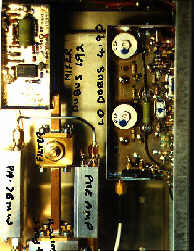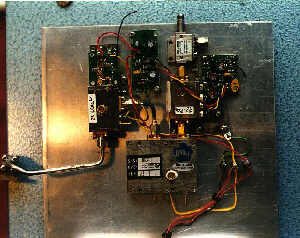
In the UK, there seem to be several popular routes to getting on 24GHz narrowband, mainly based on using the DB6NT modules or the surplus "Grey Cube" boxes, or some combination of the two. A typical DB6NT system (this one used by G4BYV) is shown in the photography below:

This is a very easy module to build, and consists of a diode subharmonic mixer and the IF circuitry (usually 2m). It requires a 12GHz local oscillator source, for which a DDK004 2.4GHz source followed by a WDG009 x5 multiplier is usually used.
This module, with decent diodes, and well constructed, is capable of giving out maybe 0.3mW on transmit, but also generates a similar level image signal, as so needs to be followed by a narrowband filter.
A filter can be constructed in rectangular waveguide (eg WG20) and at least three, or preferably more cavities are needed to get reasonable rejection of the image.
Alternatively, a cylindrical cavity filter can be used, for example the OE9PMJ cavity filter design. Several years ago, a number of 23GHz "white box" transceivers can onto the surplus market, which included a pair of four pole cylindrical cavity filters, and these can be retuned to 12GHz, in some cases directly, and in others after milling down the cavity sizes a little. These surplus filters have been used by a number of amateurs.
Most constructors of the DB6NT Mk II transverter then build a DB6NT amplifier which can be used on receive to lower the noise figure, to maybe 3dB or even less, and on transmit, to boost the power, eg to 25mW or more. Usually, a 3 stage amplifier is built.
The Grey Cube consists of a receive converter, a DRO oscillator used as both a transmitter and as the receive LO, a transmit amplifier, and a 2 pole cavity filter. There is also an IF PCB and a regulator PCB, and a 24GHz circulator. The photograph below shows these modules "breadboard style" before conversion to the 24GHz amateur band:

The receive converter (top left of photo) can be used with a DDK004 2.4GHz oscillator, a WDG009 multiplier to 12GHz, and a DB6NT doubler to 24GHz. The external filter is needed to provide image rejection. The converter has a noise figure in the region of 9dB or so, with maybe 15dB of gain at 24GHz.
As an alternative, the DRO (bottom of photo) can be locked to 24.048GHz, for use as a receiver (and transmit) local oscillator, and several amateurs have had some success with this (eg G3PYB).
On transmit, there is no mixer in the Grey Cube, but G3PYB has done some experimentation with a receiver converter, and was able to use this on transmit.
One of the most useful parts of the Grey Cube is the transmit amplifier (upper centre right in photo), since this can provide up to 100mW output, with 10dB of gain at this power level. It was designed to be driven by the DRO, at the 10 to 15mW level, so if used with a mixer, additional gain, eg from a DB6NT amplifier will be needed to drive it.
Finally, the circulator (upper centre in photo) can be used for antenna changeover.
There are various notes on modifying the Grey Cubes, which were published in the RSGB Microwave Newsletter over the last year or in the RAL 1996 round table notes.
There are other items of suplus equipment about and other designs which can be used for 24GHz narrowband.
Previously mentioned, the "White Boxes" contain a pair of cavity filters, waveguide to SMA transitions, a 26GHz sma (actually K connectors) 12V relay, plus transmit and receive chains. The problem with the transmit and receive chains is that they are centered on around 23GHz or so, built on alumina substrates, and not easily retuned to 24GHz - though not impossible.
There are various designs from JE1AAH, including amplifer designs (LNA, HPA). See ARRL Microwave Update Proceedings, plus some of the info is in Dubus.
There are other DB6NT modules - the original transverter design, and a doubler previously mentioned. See Dubus.
This section is still under construction. Contributions to it are welcome. E-mail to steve.davies@nmp.nokia.com
G4KNZ